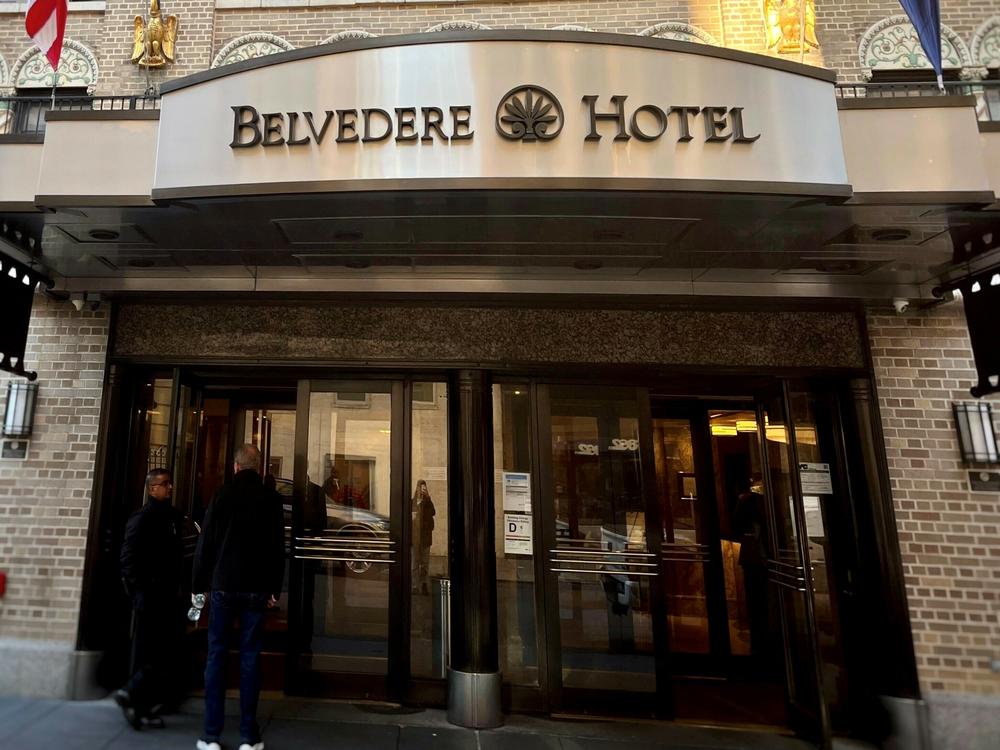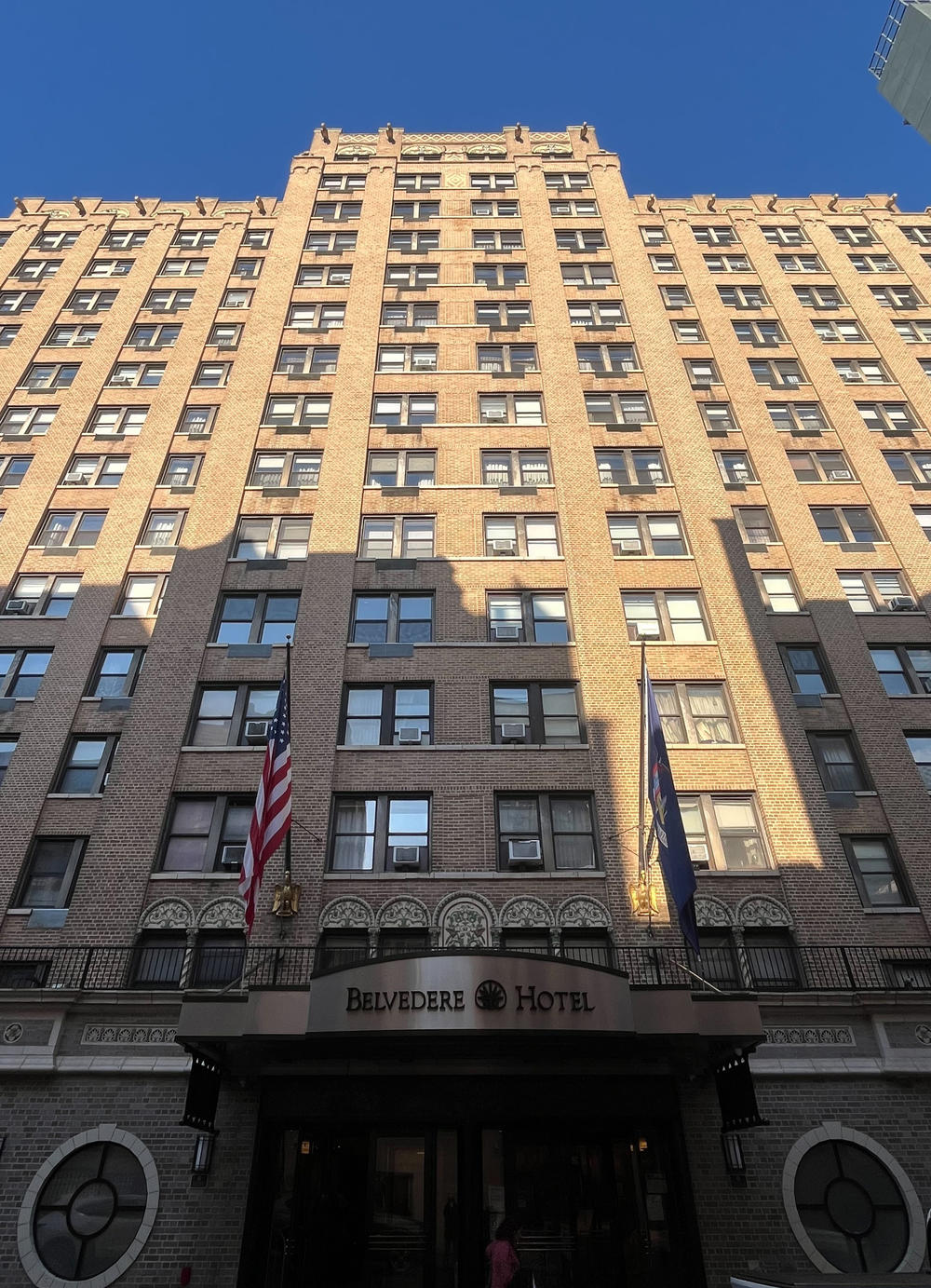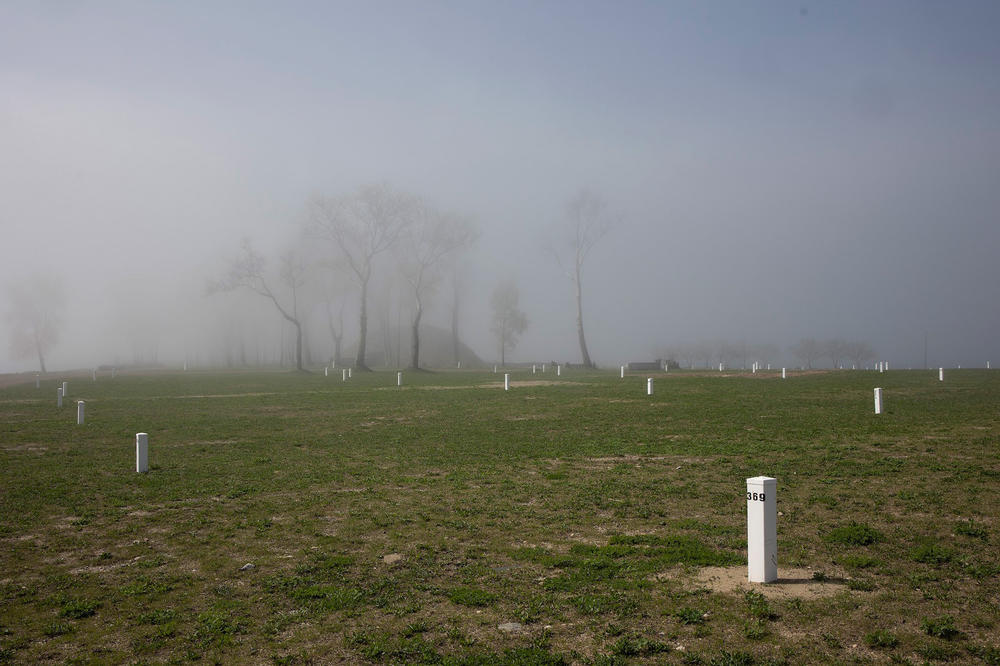Section Branding
Header Content
She lived in a New York hotel for more than 40 years. But her life was a mystery
Primary Content
This is the fifth story in The Unmarked Graveyard: Stories from Hart Island series from Radio Diaries. You can listen to the next installment on All Things Considered, and read and listen to previous stories in the series here.
This story begins in room 208 of The Belvedere Hotel.
Sitting in the heart of Manhattan's theater district on West 48th Street, the hotel is used to having guests come and go as they see the sights and catch a show.
Yet for a few dozen, the Belvedere is home. They came to New York from all parts of the world decades earlier, and stayed on in rent-stabilized rooms as the hotel changed owners and the city changed around them.
Among them was Hisako Hasegawa in room 208. She would live in the Belvedere for more than 40 years, yet remain a mystery even to those who saw her daily. That anonymity would follow her in death.
Hasegawa was born in Japan in 1934 and it's believed she came to New York in the '70s. She was well liked among the hotel staff. They recall how she would walk through the lobby on Friday mornings with a shopping cart, saying hello to everyone with a huge smile. She responded to simple acts of kindness with thank you letters.
"If you wrote her a rent receipt, for example, you would magically find a hand-drawn card the next day on your desk," recalled Ali Mahmood, who works for the hotel's owners. "Someone took 45 minutes to make that card."
A bellhop named Jerry remembers her handwriting: "It was beautiful, like poetry. I've never seen something like that."
Renee Querijero lived across the hall from Hasegawa and perhaps came the closest to knowing her.
"As far as the nearest neighbor, I'm the only one who she talks to and she knows my name," Querijero said. "[But she] doesn't say so much, you know, except the usual greetings, 'How are you? Weather is nice. I'm gonna get my mail.'" Querijero often played piano in the evenings after work and Hasegawa could hear the music carrying through the walls. She would stop Querijero in the hallway to thank her for playing, saying how nice it was to hear it.
Other long-term Belvedere residents, like Nancy Boyce, shared the hotel experience with Hasegawa and understood the way of life there.
Boyce came to the Belvedere in the early 1980s and moved into an apartment the same size as Hasegawa's — one big space serving as both living room and bedroom, with a private bathroom and a tiny kitchen nook the size of a closet. There were few appliances, but there was a hot plate and a hotel-sized refrigerator.
Boyce intended to stay for just a year but it was rent-stabilized, so she stayed on. She married and had a baby and raised him at the Belvedere, but it wasn't easy.
"People who don't know, like tourists or friends, they say, 'Wow, you live in a hotel, in the heart of the city.' It's a big deal for them," she said. But the small space wears on Boyce: "Having lived here for such a long time, for decades, I can't stand this apartment."
"At the end of the day, I feel lucky I have my family and a wide circle of friends," she said. "But I see a lot of older people, like Hisako [Hasegawa], they are all alone."
At one time, there were many affordable places where a single person like Hasegawa could live in New York City. Many hotels offered accommodations consisting of a single bed in a cubicle, or a private room with a shared kitchen and bathroom.
In the mid-20th century there were close to 200,000 units designated as SROs — single room occupancy. But by the 1970s, they had gained a reputation as hotbeds for criminal activity and the city began to shut them down. Today, advocates argue that SROs are not the problem, but a possible solution to providing affordable housing in an increasingly unaffordable city.
One day, in 2016, Jerry the bellhop realized that Hasegawa hadn't come down. Management went to check and found she had died in her apartment. She was 82.
Querijero came home from work to find the hallway filled with police. One of the investigators started asking questions about Hasegawa's family and friends. Querijero realized that after all these years of living across the hall, she had never seen Hasegawa with anyone — a thought that still troubles her.
"I should have asked her. They think you are intruding or something, but no, that's a misconception, I think you should ask," she said.
None of the hotel staff remember Hasegawa having any visitors either.
"New York is a place for the dreamers and we all come from somewhere," said Ali Mahmood. "To leave, and leave your families behind, one would hope that you'd find love and meet people, have a family and maybe not end up alone in a hotel room somewhere."
Hasegawa was buried in a mass grave in plot 379 on New York's Hart Island, America's largest public cemetery.
This story was produced by Nellie Gilles of Radio Diaries. It was edited by Joe Richman, Deborah George and Ben Shapiro. Thanks also to Alissa Escarce, Mycah Hazel and Lena Engelstein of Radio Diaries. This story is the fifth in a series called The Unmarked Graveyard: Stories from Hart Island. You can find other stories from Hart Island on the Radio Diaries Podcast.
Copyright 2023 NPR. To see more, visit https://www.npr.org.



